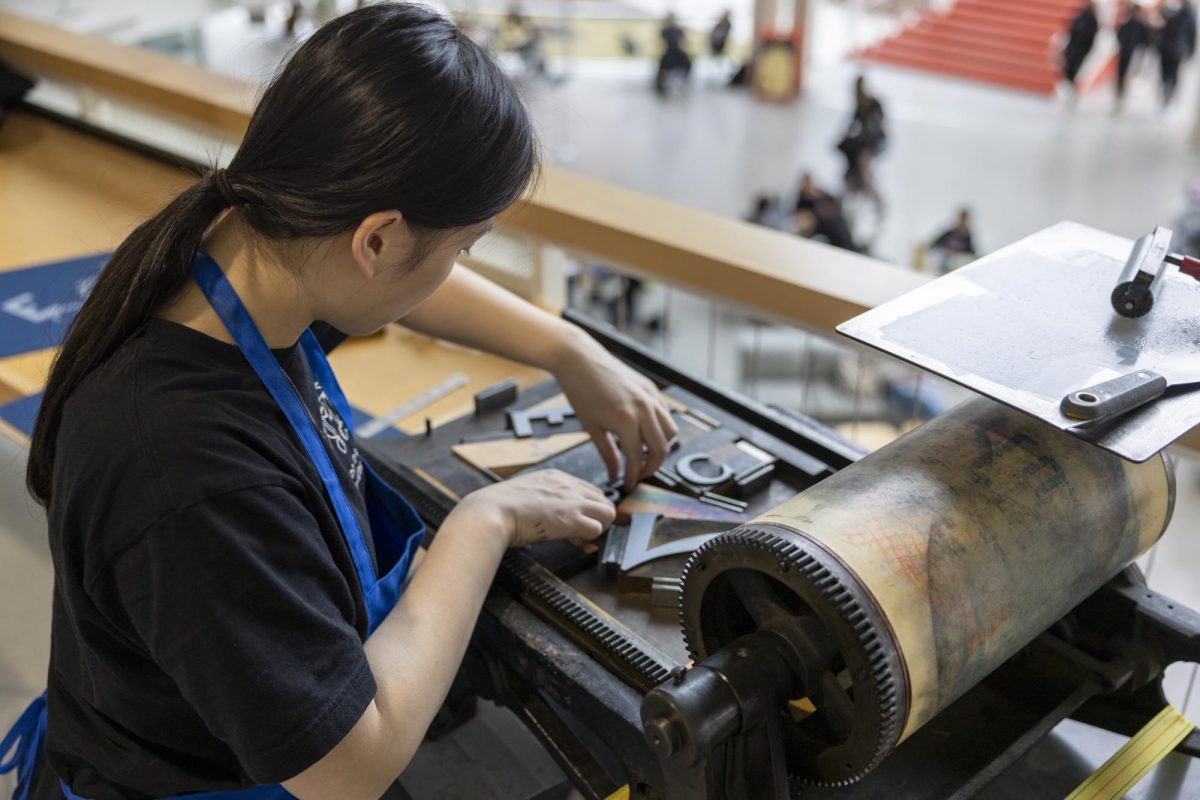The History of the Printing Press at RIT
Among students today, it may be a little known fact that RIT once had one of the best printing programs in the country, housing a range of classes including typography, design, color balance and bookbinding. At one point, RIT was the only school in the country that offered a graduate program in printing.
Back then — and up until the 2010s — RIT also had a printing fraternity: Gamma Epsilon Tau. Founded in 1955 with thirty printing students, the fraternity was dedicated to the “preservation and furtherance of the Graphic Arts.” Moreover, Reporter used to be typeset and printed within the printing school. From 1951 to 2012, a person titled a “compositor” was responsible for inputting the type that would be used to print the papers.
There is no longer a standalone printing school at RIT, and what is left of these programs has largely been absorbed by the College of Engineering Technology (CET). Few students use old printing presses now that the printing labs on campus offer much simpler methods than the long process of typesetting and pressing ink onto paper. Yet, the printing press is still present in many ways.
Relics of the Press
On the second floor of the Wallace Library, an exhibit called “Milestones in Printing” holds a wide array of printing presses and artifacts. These artifacts range from large pieces such as the folder of a Heidelberg Printing Press (a section used to fold finished printed papers into brochures, booklets and other shapes) to a small toy letterpress intended to get children into printing hobbies. Several paintings on the wall come from the “Graphic Communications Through the Ages” series, depicting people from various time periods working on presses or press-related works.
The presses in this room are not simply for display. Students are allowed to use them during classes or projects, as they are all fully functional. In addition, one press — a wooden common press — is a reconstruction created by RIT students in 2016. Dubbed the “Uncommon Press,” it was made by students Seth Gottlieb, Ferris Nicolais, Randall Paulhamus, Veronica Hebbard and Daniel Krull as a senior capstone project.
An exhibit of Goudy Type sits in an organizational type tray. It was created by Frederic Goudy, an American type designer — responsible for Copperplate Gothic and Goudy Old Style, as well as many other typefaces.
Amelia Fontanel, the associate curator of the Cary Graphic Arts Collection stated, “His studio burned down in 1939, so what you see in that exhibit, in those trays, is actually the only big collection of his type.”
A plaster cast of his right hand is also on display, known as “The Goudy Paw.” An old RIT legend says that anyone who touches it will have bad luck for an unspecified amount of time, and thus it is kept behind glass to take away onlookers’ temptations.
A couple older relics from Asia reside in a different display case: a 1798 woodblock from Japan and a piece of bronze alloy printing type from 15th-century Korea. These pieces speak to RIT’s desire to honor the rich history of printing across the world.
The RIT Press
Even though RIT has moved away from traditional book printing, the practice is still alive and well at RIT Press. A not-for-profit scholarly book publisher at RIT, RIT Press offers over 150 books, journals and eBooks covering topics from regional history to comic studies.
David Pankow, a now-retired curator of RIT’s Cary Collection, founded RIT Press in 2001 on an interesting premise: RIT had all the resources necessary to create books — with programs in printing, graphic design and photography — so why not start making them? From there, the Cary Graphic Arts Press was created, which eventually evolved into the RIT Press. As a part of the Melbert B. Cary Jr. Graphic Arts Collection, the RIT Press originally focused mostly on graphic communication, but over time it expanded its purpose.
Laura DiPonzio Hiese, the interim director of RIT Press, stated, “While embracing this broader scope, we remain committed to our RIT heritage through our continued emphasis of publications focused on graphic design, photography and printing.” The RIT Press publishes 8–10 titles per year, and each is custom designed.
The Printing Press at RIT Today
The tradition of the printing press lives on in other places at RIT today. One example is the Cary Press Room on the second floor of the SHED. Much of the material within is left over from the RIT School of Printing and is used in various classes.
According to Fontanel, “Any faculty can ask for some kind of learning experience using this kind of historic print production, because there are so many synergies that we can link between the printed word and whatever curriculum is being studied. Print was such a huge part of every single human endeavor.”
Professors are more than welcome to have their students practice graphic design, learn about history, study analog machines or better understand the history of printing.
The room is used not only to teach students how to use the machines to create print pieces, but also to teach students how to make their own typography. It is possible to print with any material as long as they have a “relief surface,” or a surface where some of the design is raised in order to create an image when covered with ink. In addition to metal type and historic wood type collections, the students can also use laser printers, 3D printers or other techniques to create new types out of wood, plastic or metal. One last place where printing techniques are preserved at RIT — perhaps not surprisingly — is in the Department of Packaging and Graphic Media Science. Though many media forms that previously involved printing have now transitioned online, packaging is one example that remains in demand. Whether they realize it or not, students involved in packaging science are participating in a centuries-old tradition.
However, RIT’s printing legacy is not exclusively theirs. Any student can take a class in the Cary Press Room, visit the RIT Archives to learn more about RIT’s printing history or view the exhibition of printing presses on the second floor of Wallace. For students who wish to participate in the rich trade of printing, the door is wide open — and they are more than welcome to step through it.







